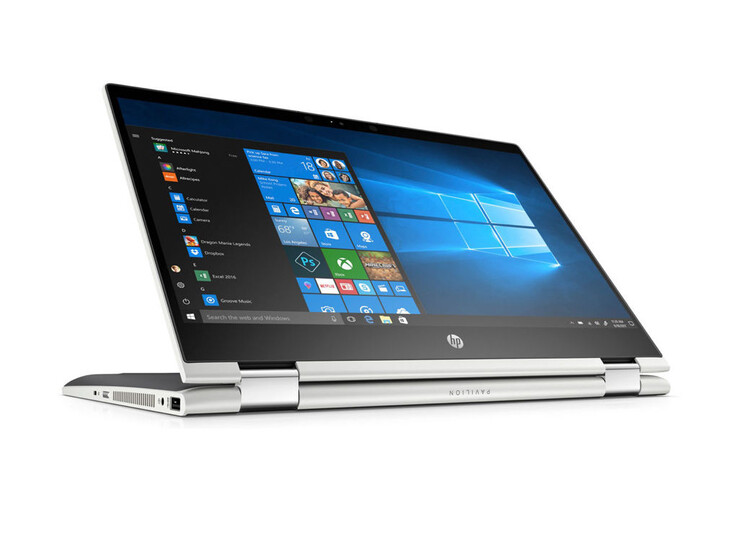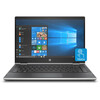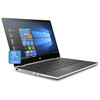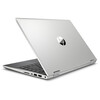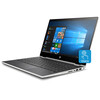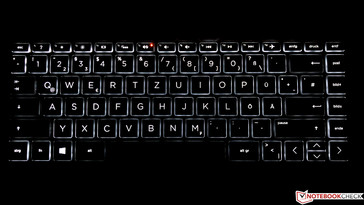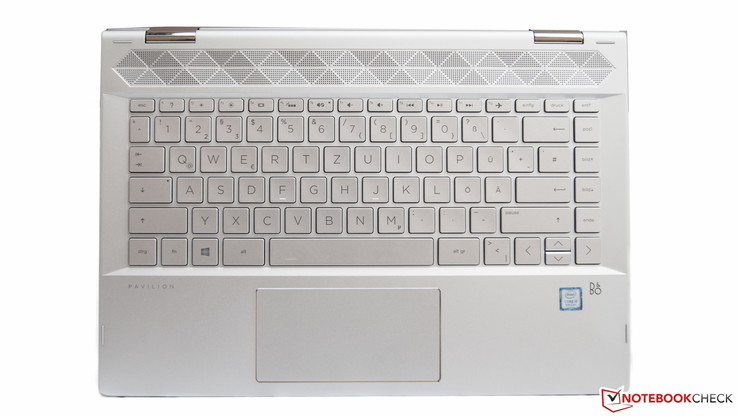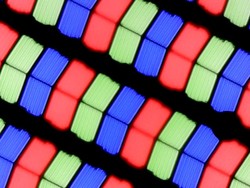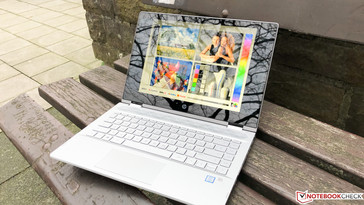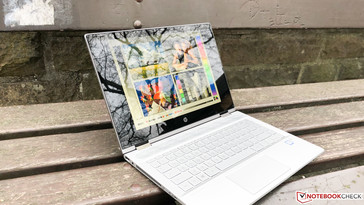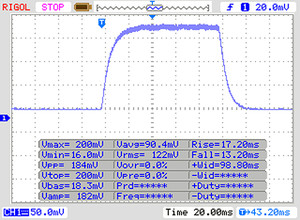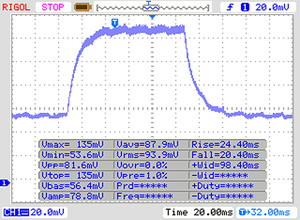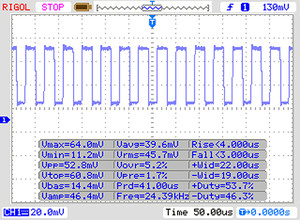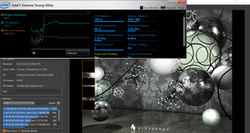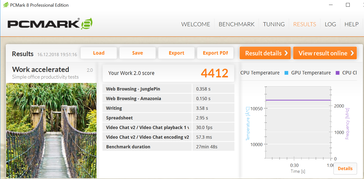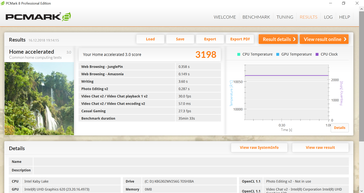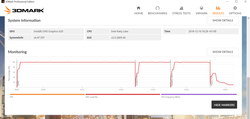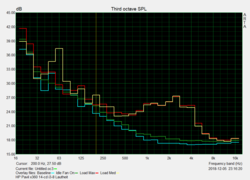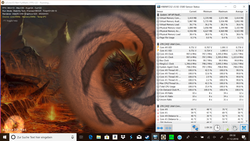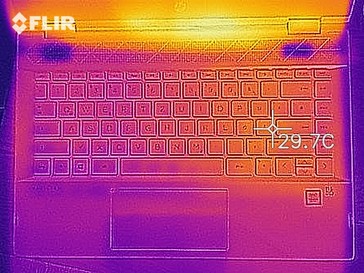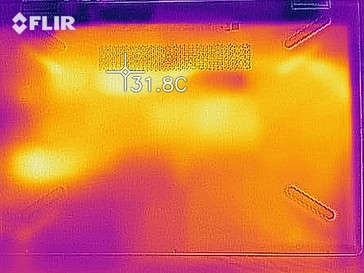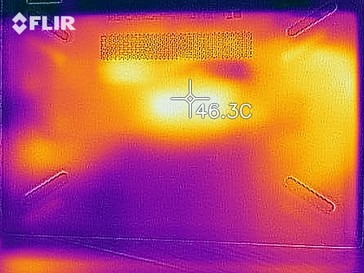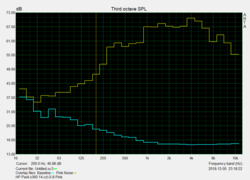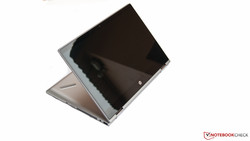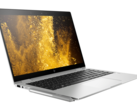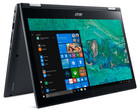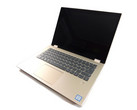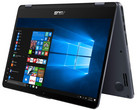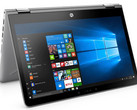HP Pavilion x360 (Core i3-8130U, 256 GB SSD) Convertible Review

The Pavilion x360 is one of HP's familiar convertible-series and we already reviewed multiple devices in the past. The manufacturer now offers a new model with some design improvements.
The internal components are still the big changes. Our test model for 700 Euros (~$797) is equipped with an Intel Core i3-8130U processor, which is supposed to offer performance levels on par with a Skylake i5 chip. You also get a 256 GB SSD and 8 GB RAM. There is no discrete GPU, so all the graphics calculations are handled by the Intel UHD Graphics 620.
We want to find out whether the 14-inch convertible can keep up with the pricier competition and whether the development of the Pavilion x360-series takes the right turn.
For comparison, we use the Lenovo Yoga 520 and Asus VivoBook Flip 14, which retail for about 900 Euros (~$1025). They are equipped with an Intel Core i5-7200U, a 256 GB SSD, and 8 GB memory. The Acer Spin 3 is another rival, but Acer's system is already powered by a more modern Intel Core i5 CPU based on the Kaby Lake architecture.
Case - Elegant but with creaking sounds
The latest iteration of the Pavilion x360 is slim and looks good. The lid is dark-silver and is similar to the current MacBook lineup, but it is only plastic, even though it looks like aluminum. Only the base unit (except for the bottom cover) is made of metal. This metal/plastic combination is also used by the rivals, and the more expensive Acer Spin 3 is only made of plastic.
Besides the ports at the sides, the look of the keyboard unit also changed compared to the previous model. It is now lower in the base unit and the speaker grille at the top was replaced by a new pattern consisting of triangles.
At about 1.6 kg, the test model is comparable to the rivals, and you can use the tablet mode pretty comfortably for a short period of time.
Thanks to the low weight and the slim construction, the x360 is a perfect companion and can easily fit in bags or backpacks.
Both the design and the haptic impression are pretty sophisticated, but we can still hear slight creaking sounds from the hinges when we open the lid. The base unit also creaks when we try to twist it.
There are no special maintenance hatches, but you have to remove the whole bottom cover to access the components.
The comparison devices hardly differ in terms of weight or size. We only notice that the new Pavilion x360 is almost 3 mm deeper compared to the previous model.
Connectivity
The new Pavilion has a total of four USB 3.1 ports (1x USB Type-C), so there is one more than before. The fingerprint scanner at the right side of the notebook is also new.
HP changed the position of the power button, which is now located right next to the volume rocker. Both control elements are easy to reach and we like the port layout in general.
SD Card Reader
We always use our reference card from Toshiba (Exceria Pro SDXC 64 GB UHS-II) to test the performance of the integrated SD-card reader. Our test model almost manages 70 MB/s when we copy a folder with jpeg images (~5 MB each), which is very close to the ~80 MB/s of the Lenovo Yoga convertible. Both the Asus VivoBook Flip 14 and Acer Spin 3 fall behind with less than 25 MB/s.
| SD Card Reader | |
| average JPG Copy Test (av. of 3 runs) | |
| HP Pavilion x360 14-ba011ng (Toshiba Exceria Pro SDXC 64 GB UHS-II) | |
| Lenovo Yoga 520-14IKB 80X80097GE (Toshiba Exceria Pro SDXC 64 GB UHS-II) | |
| Average of class Convertible (28.1 - 209, n=23, last 2 years) | |
| HP Pavilion x360 14-cd0002ng (Toshiba Exceria Pro SDXC 64 GB UHS-II) | |
| Asus VivoBook Flip 14 TP410UA-EC242T (Toshiba Exceria Pro SDXC 64 GB UHS-II) | |
| Acer Spin 3 SP314-51-548L (Toshiba Exceria Pro SDXC 64 GB UHS-II) | |
| maximum AS SSD Seq Read Test (1GB) | |
| Average of class Convertible (28.9 - 253, n=22, last 2 years) | |
| Lenovo Yoga 520-14IKB 80X80097GE (Toshiba Exceria Pro SDXC 64 GB UHS-II) | |
| HP Pavilion x360 14-ba011ng (Toshiba Exceria Pro SDXC 64 GB UHS-II) | |
| HP Pavilion x360 14-cd0002ng (Toshiba Exceria Pro SDXC 64 GB UHS-II) | |
| Asus VivoBook Flip 14 TP410UA-EC242T (Toshiba Exceria Pro SDXC 64 GB UHS-II) | |
| Acer Spin 3 SP314-51-548L (Toshiba Exceria Pro SDXC 64 GB UHS-II) | |
Communication - Below average
The WLAN module from Realtek is much slower than the competition. The previous model of the x360 series still used the Intel Dual Band Wireless-AC 3168 module, even though it was not faster, either.
The new HP Pavilion x360 is also 150-200 Mbps slower than the average for this segment.
The manufacturer also includes a 720p webcam, but the picture quality is – as expected – pretty bad. Pictures are very noisy, even in well-lit environments, and the colors are washed-out.
Accessories
The box of the Pavilion x360 only includes the corresponding power adapter. The spec sheet only lists recommended accessories, but there are no dedicated accessories for the system. A stylus for the Pavilion-series is not available, either.
Maintenance
We already mentioned that there are no maintenance hatches.
To get access to the innards, you have to remove the whole bottom cover, which is secured by three visible screws at the front as well as the rubber support feet, which hide two additional screws. Several YouTube videos show that you still have to be careful when removing the cover. We recommend this process is only performed by experienced/trained users. We stopped the process to prevent any damage to our test model.
Warranty
The manufacturer only ships the convertible with a one-year warranty, but you can purchase an upgrade to three years for 60 Euros (~$68). Please see our Guarantees, Return policies and Warranties article for country-specific information.
Input Devices - Small improvement
Keyboard
The position of the keyboard is now a bit lower, but the keyboard layout itself is identical to the previous Pavilion x360. However, we notice a small difference on the lettering, because the signs on the arrow keys and the regular keys are now bigger. The keyboard is also equipped with a single-level illumination to improve the visibility in darker environments. The lettering is now transparent, so the light can shine through it.
However, the keyboard does not leave a good quality impression. You can dent it easily and there are some creaking sounds when you type with some force. Fast typing also feels a bit spongy due to the smooth surface. We like the precise pressure point and the sufficiently long and soft key travel, though.
All in all, the keyboard is still okay for daily office and multimedia tasks, despite its shortcomings. But you should use an external keyboard if you are looking for a serious office device for work.
Touchpad
Display
HP updated and tweaked some aspects for the new Pavilion x360 but unfortunately forgot about the display. The only positive aspect is the IPS technology that the 1080p screen is based on. It uses PWM to regulate the brightness, but the frequency is comparatively high at 1439 Hz and should not be an issue. The average luminance does not even hit 200 nits, which is completely insufficient for a modern device. We only measure 165 nits in the lower right corner.
The rivals from Lenovo or Acer are not equipped with particularly bright panels, either, but both models still manage at least 220 nits. Asus' VivoBook Flip 14 offers a brighter panel with good brightness distribution.
| |||||||||||||||||||||||||
Brightness Distribution: 72 %
Center on Battery: 218 cd/m²
Contrast: 1607:1 (Black: 0.14 cd/m²)
ΔE ColorChecker Calman: 5.44 | ∀{0.5-29.43 Ø4.78}
ΔE Greyscale Calman: 3.98 | ∀{0.09-98 Ø5}
62% sRGB (Argyll 1.6.3 3D)
39% AdobeRGB 1998 (Argyll 1.6.3 3D)
42.74% AdobeRGB 1998 (Argyll 3D)
61.8% sRGB (Argyll 3D)
41.32% Display P3 (Argyll 3D)
Gamma: 2.32
CCT: 6163 K
| HP Pavilion x360 14-cd0002ng Chi Mei CMN14D9, , 1920x1080, 14" | HP Pavilion x360 14-ba011ng Chi Mei, , 1920x1080, 14" | Lenovo Yoga 520-14IKB 80X80097GE BOE NV140FHM-N49, , 1920x1080, 14" | Asus VivoBook Flip 14 TP410UA-EC242T Chi Mei N140HCE-EN1, , 1920x1080, 14" | Acer Spin 3 SP314-51-548L BOE CQ NV140FHM-N41, , 1920x1080, 14" | |
|---|---|---|---|---|---|
| Display | 1% | -4% | 59% | -4% | |
| Display P3 Coverage (%) | 41.32 | 41.82 1% | 39.76 -4% | 66.7 61% | 39.68 -4% |
| sRGB Coverage (%) | 61.8 | 61.6 0% | 59.3 -4% | 96.6 56% | 58.9 -5% |
| AdobeRGB 1998 Coverage (%) | 42.74 | 43.33 1% | 41.08 -4% | 68.9 61% | 41 -4% |
| Response Times | 17% | -10% | 13% | -8% | |
| Response Time Grey 50% / Grey 80% * (ms) | 44 ? | 41 ? 7% | 47 ? -7% | 34 ? 23% | 43 ? 2% |
| Response Time Black / White * (ms) | 30 ? | 22 ? 27% | 34 ? -13% | 29 ? 3% | 35 ? -17% |
| PWM Frequency (Hz) | 2439 ? | 25000 ? | 347 ? | 24750 ? | 1000 |
| Screen | -12% | 8% | 29% | 10% | |
| Brightness middle (cd/m²) | 225 | 252 12% | 255 13% | 327 45% | 220 -2% |
| Brightness (cd/m²) | 195 | 237 22% | 247 27% | 308 58% | 221 13% |
| Brightness Distribution (%) | 72 | 90 25% | 83 15% | 90 25% | 78 8% |
| Black Level * (cd/m²) | 0.14 | 0.21 -50% | 0.21 -50% | 0.23 -64% | 0.18 -29% |
| Contrast (:1) | 1607 | 1200 -25% | 1214 -24% | 1422 -12% | 1222 -24% |
| Colorchecker dE 2000 * | 5.44 | 7.29 -34% | 4.5 17% | 2.63 52% | 3.98 27% |
| Colorchecker dE 2000 max. * | 20.38 | 17.55 14% | 7.21 65% | 6.58 68% | 7.69 62% |
| Greyscale dE 2000 * | 3.98 | 7.48 -88% | 2.96 26% | 4.11 -3% | 1.68 58% |
| Gamma | 2.32 95% | 2.45 90% | 2.3 96% | 2.45 90% | 2.37 93% |
| CCT | 6163 105% | 6953 93% | 6965 93% | 7352 88% | 6382 102% |
| Color Space (Percent of AdobeRGB 1998) (%) | 39 | 40 3% | 38 -3% | 63 62% | 38 -3% |
| Color Space (Percent of sRGB) (%) | 62 | 61 -2% | 59 -5% | 97 56% | 58 -6% |
| Colorchecker dE 2000 calibrated * | 4 | ||||
| Total Average (Program / Settings) | 2% /
-6% | -2% /
3% | 34% /
33% | -1% /
5% |
* ... smaller is better
The deviations of the grayscale and the colors are low thanks to the IPS technology. There is no visible blue cast, either, but the panel is not suited for professional graphics work due to the limited color gamut. We only measure 62% sRGB and 39% AdobeRGB, respectively.
Display Response Times
| ↔ Response Time Black to White | ||
|---|---|---|
| 30 ms ... rise ↗ and fall ↘ combined | ↗ 17 ms rise | |
| ↘ 13 ms fall | ||
| The screen shows slow response rates in our tests and will be unsatisfactory for gamers. In comparison, all tested devices range from 0.1 (minimum) to 240 (maximum) ms. » 79 % of all devices are better. This means that the measured response time is worse than the average of all tested devices (20.2 ms). | ||
| ↔ Response Time 50% Grey to 80% Grey | ||
| 44 ms ... rise ↗ and fall ↘ combined | ↗ 24 ms rise | |
| ↘ 20 ms fall | ||
| The screen shows slow response rates in our tests and will be unsatisfactory for gamers. In comparison, all tested devices range from 0.165 (minimum) to 636 (maximum) ms. » 72 % of all devices are better. This means that the measured response time is worse than the average of all tested devices (31.6 ms). | ||
Screen Flickering / PWM (Pulse-Width Modulation)
| Screen flickering / PWM detected | 2439 Hz | ≤ 30 % brightness setting | |
The display backlight flickers at 2439 Hz (worst case, e.g., utilizing PWM) Flickering detected at a brightness setting of 30 % and below. There should be no flickering or PWM above this brightness setting. The frequency of 2439 Hz is quite high, so most users sensitive to PWM should not notice any flickering. In comparison: 53 % of all tested devices do not use PWM to dim the display. If PWM was detected, an average of 8111 (minimum: 5 - maximum: 343500) Hz was measured. | |||
Performance
Our test model of the HP Pavilion x360 is equipped with an Intel dual-core processor, 8 GB single-channel RAM as well as a fast 256 GB SSD. This combination should be powerful enough for common office and multimedia tasks. Our test model retails for about 700 Euros (~$797).
There are two additional SKUs if you need more performance. Both of them are shipped with a 128 GB SSD in combination with a 1 TB hard drive, a discrete Nvidia MX130 GPU, and a quad-core CPU. The Intel Core i5 SKU is available for 850 Euros (~$968), while the i7 SKU retails for 1000 Euros (~$1139).
Processor - The i3 is (usually) fast enough
The heart of HP's new convertible is an Intel Core i3-8310U processor with a base frequency of 2.2 GHz (3.4 GHz Boost). It has two native CPU cores and provides sufficient performance for everyday office tasks, and there is even some headroom for more-demanding applications.
The CPU cannot maintain its full Boost clock in Cinebench R15 but levels off at a steady frequency of 2.8 GHz and therefore above the base clock.
Our Cinebench R15 Multi loop shows that the score hardly fluctuates at all. There is only a minor drop after the first run before it levels off at ~320 points.
All in all, the performance of the new HP Pavilion x360 is basically identical to the rivals and the previous model. Only the Acer Spin 3 manages up to 523 points thanks to its quad-core processor.
There is no performance penalty if you use the laptop on battery power, and Cinebench confirms the results on mains.
More comparisons and benchmark results are listed in our benchmark table for modern notebook processors.
System Performance
The combination of fast SSD storage and the Intel Core i3 CPU works well. The Pavilion x360 was always responsive and smooth during our review period. This is supported by the PCMark 8 result, which is okay at 3200 points. Still, the comparison devices as well as the previous model with the Intel Core i5 perform slightly better.
| PCMark 8 Home Score Accelerated v2 | 3198 points | |
| PCMark 8 Work Score Accelerated v2 | 4412 points | |
| PCMark 10 Score | 3153 points | |
Help | ||
Storage Devices
We already mentioned that the SKUs of the Pavilion x360 use different storage solutions. Our test model is equipped with a 256 GB M.2-SSD from Toshiba. The transfer rates vary between 700 MB/s (sequential write) up to 1200 MB/s (sequential read) thanks to the PCIe interface. None of the listed competitors can keep up with the performance, despite their higher price.
| HP Pavilion x360 14-cd0002ng Toshiba KBG30ZMV256G | Lenovo Yoga 520-14IKB 80X80097GE Intel SSD 600p SSDPEKKW256G7 | Acer Spin 3 SP314-51-548L Micron 1100 MTFDDAV256TBN | Average Toshiba KBG30ZMV256G | |
|---|---|---|---|---|
| AS SSD | 13% | -23% | -7% | |
| Seq Read (MB/s) | 1225 | 1367 12% | 491.1 -60% | 1283 ? 5% |
| Seq Write (MB/s) | 764 | 561 -27% | 406.9 -47% | 676 ? -12% |
| 4K Read (MB/s) | 41.45 | 33.13 -20% | 25.41 -39% | 42.7 ? 3% |
| 4K Write (MB/s) | 90.5 | 110.2 22% | 77.9 -14% | 87.7 ? -3% |
| 4K-64 Read (MB/s) | 584 | 279.3 -52% | 236.1 -60% | 575 ? -2% |
| 4K-64 Write (MB/s) | 224.9 | 495.4 120% | 273.6 22% | 270 ? 20% |
| Access Time Read * (ms) | 0.138 | 0.092 33% | 0.091 34% | 0.2746 ? -99% |
| Access Time Write * (ms) | 0.229 | 0.033 86% | 0.056 76% | 0.3361 ? -47% |
| Score Read (Points) | 748 | 449 -40% | 311 -58% | 746 ? 0% |
| Score Write (Points) | 392 | 662 69% | 392 0% | 426 ? 9% |
| Score Total (Points) | 1511 | 1312 -13% | 867 -43% | 1536 ? 2% |
| Copy ISO MB/s (MB/s) | 574 | 579 1% | 329.8 -43% | 761 ? 33% |
| Copy Program MB/s (MB/s) | 263.4 | 227.4 -14% | 158.8 -40% | 243 ? -8% |
| Copy Game MB/s (MB/s) | 424.9 | 425.7 0% | 231.9 -45% | 457 ? 8% |
* ... smaller is better
GPU Performance
We already listed the three different SKUs of the HP Pavilion x360. Two of them are equipped with the GeForce MX130 GPU, but our model only gets the iGPU of the processor. It has the designation Intel UHD Graphics 620, which is basically the old Intel HD Graphics 620 with slightly increased clocks. It is primarily designed for office and multimedia tasks, but the gaming performance is affected by the missing dual-channel memory configuration. Only older titles are playable at the lowest settings.
The iGPU is 15-17% slower than the average result for the UHD Graphics 620 in our database, which is caused by the single-channel RAM with reduced memory bandwidth. The rivals are on a similar performance level; only the Acer Spin 3 is about 15% faster, despite the single-channel RAM. We recommend checking out the Pavilion x360 with the dedicated Nvidia GeForce MX130 GPU if you need more 3D performance.
The GPU performance is not reduced on battery power. More benchmarks and details on more notebook GPUs are available in our tech section.
| 3DMark 11 Performance | 1568 points | |
| 3DMark Cloud Gate Standard Score | 6007 points | |
Help | ||
Gaming Performance
The utilization of the iGPU in combination with a single-channel memory configuration reduces the gaming capabilities of the convertible dramatically. You are limited to older titles at low details and resolutions.
The game BioShock Infinite from 2013 is one example where we only get ~40 FPS at the lowest preset. The GeForce MX130 GPU, which is also available for the Pavilion x360, managed 130 FPS on average and about 60 FPS with high settings.
More gaming benchmarks with the Intel UHD Graphics 620 are listed here.
| low | med. | high | ultra | |
|---|---|---|---|---|
| BioShock Infinite (2013) | 45.9 | 23.44 | 20.41 | 6.94 |
| The Witcher 3 (2015) | 12.7 | 8 | 4.2 | 2.97 |
| Rise of the Tomb Raider (2016) | 16.9 | 10 | 5.4 | 3.8 |
Emissions
System Noise
The Lenovo Yoga 520 turned out to be a quiet companion during our review and only started to get louder under load. HP's convertible, however, shows issues similar to the Acer Spin 3. The boot process of the test model is already very audible, and we can also notice a somewhat worrying murmur of the fan. The fan is also quite sensitive to RPM changes when you launch apps. The maximum fan noise is okay at 36.6 dB(A), but the fan control still leaves an obtrusive and negative impression due to the pulsating behavior.
Noise level
| Idle |
| 31 / 31 / 31 dB(A) |
| Load |
| 36.5 / 36.6 dB(A) |
 | ||
30 dB silent 40 dB(A) audible 50 dB(A) loud |
||
min: | ||
Temperature
We cannot measure uncomfortable surface temperatures, neither while idling, nor under load. Most of the surfaces hardly surpass 30 °C under load. The hot spot at the bottom on the other hand can reach almost 42 °C. There is no noticeable temperature increase during everyday tasks, either.
We also want to check how the hardware performs in an extreme load scenario. We use the synthetic tools Prime95 and FurMark, and the CPU starts to drop below its base frequency (throttling) after a short while. The average clock after our one-hour stress test is ~1.2 GHz (base frequency 2.2 GHz).
Such an extreme scenario is very rare in practice (even during gaming), so the throttling is not a big deal. The general performance is not affected, because a 3DMark 11 run immediately after the stress test determines a similar score.
(+) The maximum temperature on the upper side is 33.7 °C / 93 F, compared to the average of 35.4 °C / 96 F, ranging from 19.6 to 60 °C for the class Convertible.
(±) The bottom heats up to a maximum of 41.6 °C / 107 F, compared to the average of 36.8 °C / 98 F
(+) In idle usage, the average temperature for the upper side is 25.2 °C / 77 F, compared to the device average of 30.3 °C / 87 F.
(+) The palmrests and touchpad are cooler than skin temperature with a maximum of 29.1 °C / 84.4 F and are therefore cool to the touch.
(±) The average temperature of the palmrest area of similar devices was 27.9 °C / 82.2 F (-1.2 °C / -2.2 F).
Speakers
The chassis of the HP Pavilion x360 has a Bang & Olufsen logo, but the sound is rather tinny. The volume is sufficient for a slim convertible, but bass is missing. The speakers also sound a bit distorted when you crank the volume up.
We recommend the combined stereo jack for a better sound experience. The integrated consumer sound card can produce a much richer sound when you attach external speakers or headphones.
The integrated microphone records noise-free voices, but there is no voice recognition, so ambient sounds are not filtered.
HP Pavilion x360 14-cd0002ng audio analysis
(-) | not very loud speakers (70.6 dB)
Bass 100 - 315 Hz
(±) | reduced bass - on average 12.7% lower than median
(±) | linearity of bass is average (7.6% delta to prev. frequency)
Mids 400 - 2000 Hz
(+) | balanced mids - only 3.8% away from median
(+) | mids are linear (4.2% delta to prev. frequency)
Highs 2 - 16 kHz
(±) | higher highs - on average 6.2% higher than median
(+) | highs are linear (5.7% delta to prev. frequency)
Overall 100 - 16.000 Hz
(±) | linearity of overall sound is average (18.2% difference to median)
Compared to same class
» 39% of all tested devices in this class were better, 7% similar, 54% worse
» The best had a delta of 6%, average was 20%, worst was 57%
Compared to all devices tested
» 38% of all tested devices were better, 8% similar, 54% worse
» The best had a delta of 4%, average was 24%, worst was 134%
Apple MacBook 12 (Early 2016) 1.1 GHz audio analysis
(+) | speakers can play relatively loud (83.6 dB)
Bass 100 - 315 Hz
(±) | reduced bass - on average 11.3% lower than median
(±) | linearity of bass is average (14.2% delta to prev. frequency)
Mids 400 - 2000 Hz
(+) | balanced mids - only 2.4% away from median
(+) | mids are linear (5.5% delta to prev. frequency)
Highs 2 - 16 kHz
(+) | balanced highs - only 2% away from median
(+) | highs are linear (4.5% delta to prev. frequency)
Overall 100 - 16.000 Hz
(+) | overall sound is linear (10.2% difference to median)
Compared to same class
» 7% of all tested devices in this class were better, 2% similar, 91% worse
» The best had a delta of 5%, average was 18%, worst was 53%
Compared to all devices tested
» 4% of all tested devices were better, 1% similar, 94% worse
» The best had a delta of 4%, average was 24%, worst was 134%
Energy Management
Power Consumption
HP only uses efficient components for its new convertible, which is reflected by our power measurements. The idle consumption is 4-7 W and we record a maximum consumption of 40 W. However, this value decreases as soon as the throttling sets in and levels off at ~30 W. The comparison devices are very similar in this regard.
The provided power adapter (9.2 x 3.9 x 2.5) is compact and powerful enough at a rated output of 45 W.
| Off / Standby | |
| Idle | |
| Load |
|
Key:
min: | |
| HP Pavilion x360 14-cd0002ng i3-8130U, UHD Graphics 620, Toshiba KBG30ZMV256G, IPS, 1920x1080, 14" | Asus VivoBook Flip 14 TP410UA-EC242T i5-7200U, HD Graphics 620, SK Hynix HFS256G39TND-N210A, IPS, 1920x1080, 14" | Acer Spin 3 SP314-51-548L i5-8250U, UHD Graphics 620, Micron 1100 MTFDDAV256TBN, IPS, 1920x1080, 14" | Average Intel UHD Graphics 620 | Average of class Convertible | |
|---|---|---|---|---|---|
| Power Consumption | -11% | 17% | -16% | -40% | |
| Idle Minimum * (Watt) | 3.9 | 3.9 -0% | 2.9 26% | 3.81 ? 2% | 4.43 ? -14% |
| Idle Average * (Watt) | 5.9 | 7 -19% | 5.2 12% | 6.94 ? -18% | 7.38 ? -25% |
| Idle Maximum * (Watt) | 7.1 | 9.3 -31% | 5.4 24% | 8.75 ? -23% | 9.78 ? -38% |
| Load Average * (Watt) | 29.4 | 35 -19% | 29.4 -0% | 35 ? -19% | 45 ? -53% |
| Load Maximum * (Watt) | 39 | 33 15% | 29.6 24% | 47.5 ? -22% | 67.1 ? -72% |
* ... smaller is better
Battery Runtime
The battery capacity is 41 Wh (three-cell) according to the manufacturer and the spec sheet advertises a quick-charge to 50% within 45 minutes. The claimed battery runtime is 10.5 hours. We will check the runtime in four different scenarios.
We start with the maximum battery runtime with the lowest brightness setting for the display and a reading script (wireless modules off). The result is 13 hours for the 14-inch convertible, which is average in this segment.
Our WLAN test is much more realistic and simulates everyday web-browsing at an adjusted luminance of 150 nits. The test model runs for 7.5 hours, which is once again an average result within the comparison group. Lenovo's Yoga 520 is a bit more enduring at almost 8.5 hours.
The next test is video playback, again at an adjusted luminance of 150 nits. The convertible shuts down after 5.5 hours, which is sufficient even for long movies.
The last test is the minimum runtime you can expect. The result is obviously shorter when you stress the components, and we determine a minimum runtime of two hours. The Yoga comparison device lasts one hour longer.
| HP Pavilion x360 14-cd0002ng i3-8130U, UHD Graphics 620, 41 Wh | HP Pavilion x360 14-ba011ng i5-7200U, GeForce 940MX, 41.5 Wh | Lenovo Yoga 520-14IKB 80X80097GE i5-7200U, HD Graphics 620, 53 Wh | Asus VivoBook Flip 14 TP410UA-EC242T i5-7200U, HD Graphics 620, 42 Wh | Acer Spin 3 SP314-51-548L i5-8250U, UHD Graphics 620, 52.5 Wh | Average of class Convertible | |
|---|---|---|---|---|---|---|
| Battery runtime | -16% | 38% | -8% | 12% | 79% | |
| Reader / Idle (h) | 12.7 | 14.8 17% | 25.1 ? 98% | |||
| H.264 (h) | 5.4 | 10 85% | 15.2 ? 181% | |||
| WiFi v1.3 (h) | 7.4 | 6.2 -16% | 8.3 12% | 6.8 -8% | 8.3 12% | 11.2 ? 51% |
| Load (h) | 2.1 | 2.9 38% | 1.793 ? -15% |
Verdict
Pros
Cons
A notebook or a tablet? This is the principle behind a convertible. The new HP Pavilion x360 wants to combine both devices. Our test model for 700 Euros (~$797) is powerful enough for most common tasks, but performance and a nice design is not everything.
The case consists of a plastic/metal combination, which appears noble and looks good. The decent impression is unfortunately affected by creaking sounds during use.
The input devices leave mixed impressions as well. The keyboard is okay for occasional office tasks and is illuminated, but the quality is not very good. The touchpad is better and executed our inputs quickly as well as accurately, but we would like to see bigger dimensions for the next iteration. You can obviously use the 14-inch touchscreen for inputs as well, which is a reliable input method. It is unfortunate that HP does not ship the Pavilion-series with a stylus.
Then there is the display, which is glossy and just way too dark for a modern device.
The performance on the other hand is pretty convincing; both the Intel Core i3 CPU and the storage solution ensure a responsive and fast system performance. A dual-channel memory configuration would have improved the performance even further.
The last major drawback is the fan, which is very sensitive to RPM changes, so you can hear it pretty much every time you do something.
There is a visible development, but we miss real milestones and improvements from HP.
The HP Pavilion x360 is a good and inexpensive entry-level device if you want an enduring convertible and primarily work indoors. We still recommend checking out the comparison devices and our Top 10 Convertible ranking if you have some financial headroom.
HP Pavilion x360 14-cd0002ng
- 01/03/2019 v6 (old)
Nino Richizzi




